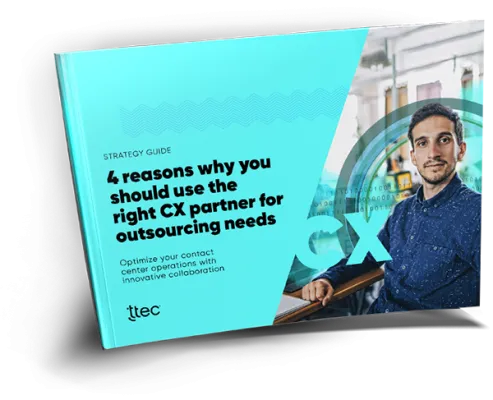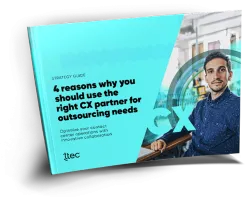My colleague Kurt in Brussels recently told me a customer experience story he experienced first-hand.
“We were just about to move into our newly built house and we were enormously frustrated with the poor service provided by our energy supplier, or rather the lack of service. That day I was contacted by my local bank on my cell phone. The associate was very friendly and started by asking me about my day and how everything was going. I told him the situation and how frustrated I was with the idea of having no electricity when moving my family into our new house.
Shortly afterwards, my cell phone rang again. It was the same bank associate. ‘I just wanted to tell you I have reached out to someone I know at the utility company and you should have power within the next couple of hours.’ I was blown away. This was totally unexpected. I have lost count of the number of people I have told this story to!”
Any CXO would be proud to have a customer experience story like this circulated about their brand, perhaps even going viral on social media. With one single interaction, Kurt had become an international brand advocate. The employee’s empathy and proactive outreach sparked the excellent experience. The associate was empowered to deal with Kurt as a human being, not just a call or ticket number. He felt that the company cared about him, and is willing to share the story with anyone who will listen.
With so much focus on technologies and tools to influence engagement and loyalty, it’s important to step back and remember that human connection plays the biggest role in driving customer loyalty. And it must start from the top, with leadership vision and commitment to enable employees to provide outstanding experiences systematically and consistently.
To earn customer loyalty, there needs to be an ongoing attachment to the brand that creates a lasting impression. Combine this with consistently delivering the service and quality your customers expect, and your quest to earn your customers’ enduring loyalty is half-won. We know that delivering what your customers expect of you results in lower levels of customer complaints. We know that service that unexpectedly delights the customer creates brand advocates. But neither of these necessarily results in true customer loyalty.
Smart organizations seeking customer loyalty are turning to Big Data, predictive analytics, and social listening. CMOs are innovating their marketing in recognition of the seismic shift caused by the rise of digital, mobile, and social. Companies are creating CXO positions with the remit of driving customer-centric strategies. Together they are harnessing the power of people and technology to personalise interactions and so create a truly human experience—one that anticipates needs, respects time, appreciates effort, and values individuality.
Company values relating to these concepts have become essential currency and not just a big poster on the wall. Brand experience, lived both internally and externally, is critical to success. Employee engagement and satisfaction metrics are increasingly being associated with customer satisfaction on the principle that “happy employees mean happy customers” and a positive impact on the bottom line.
Too often, however, leaders fall back on tools and technologies to show commitment to customers while contradicting those benefits with their actions. Without integrity and genuine regard for customers from leadership, even companies with successful rewards and points programs will fail.
Take Tesco, the British supermarket giant, once lauded for its groundbreaking data analytics that created personalised offers and discounts to customers. Its reputation is now in tatters because the company’s executives made decisions that eroded customer trust and loyalty. It was plagued by an accounting scandal, four profit warnings in a six-month period, a drop of almost 50 percent in the share price, and a dividend cut by 75 percent. The last CEO was ousted for “failure of leadership.” Less than six months into the new job, new CEO David Lewis appointed a world-class advisory team to help recover trust from consumers and investors.
Leaders’ roles in building customer loyalty
So what do leaders need to do to earn extreme customer loyalty? We are talking about the kind of loyalty that allows organizations to make mistakes—even big ones—and not lose business; the kind of loyalty that, no matter what, your customer will continue to purchase from you, be your advocate, and endorse your brand. Put simply, leaders can’t expect to earn the loyalty of their customers without first placing themselves under the microscope. It is the leader who is ultimately responsible for creating the company culture and being a role model for their executive team and employees.
Research conducted by our partners at Zenger Folkman suggests that leaders are the primary factor behind employee productivity, commitment, and bottom-line profitability. Their study of a group of 81 business leaders conducted using 360-degree assessments, showed that all but the bottom 10 percentile had a significant impact on all three outcomes (see Figure 1). However, leaders in the top 10 percentile demonstrated a series of competencies that have a massive impact: high levels of employee engagement and commitment lead to high levels of customer satisfaction.
Back to the “happy employee, happy customer” principle. We can assume a direct correlation between highly effective leadership and customer loyalty. I would also go so far as to say that the top 10 percentile are more likely to drive extreme loyalty, or as Zenger Folkman say “good leaders create more economic value than poor leaders, and extraordinary leaders create far more value than good ones.”
Further Zenger Folkman research states that improving any leadership behavior will have a positive impact, but that some changes have more impact than others. They have identified nine behaviors that, if improved, will have the most impact on employee satisfaction/commitment, and ultimately on customer loyalty (see above).
We know that when leaders develop and excel at even just three or four of these behaviors, their teams show the highest levels of employee satisfaction and commitment. Choose which behaviors would make the fastest impact on your customers and focus on those. And don’t forget to play to your strengths.
I would be very surprised if the CEO behind the bank that delivered Kurt his happy ending did not demonstrate at least half of these behaviors.
9 Behaviors That Impact Employee Engagement
1. Inspire and motivate others. When inspiration is a focus, leaders unlock a level of additional effort and energy that can make the difference between organisational success and failure.
2. Drive for results. By getting people to stay focused on and stretch for the highest priority goals, leaders will establish a culture of excellence.
3. Provide a definite sense of direction and purpose. By making a connection between the wider vision and day-to-day activities, employees will see how their hard work makes a difference to the organisation...and its customers.
4. Promote a high level of cooperation. The collaborative leader creates synergies so every employee can enjoy the work experience.
5. Be honest and act with integrity. Leaders need to take a close look in the mirror and ask themselves if their behaviors are a true reflection of the company values.
6. Be trustworthy. Employees and customers alike trust leaders who project confidence in their ability to make informed decisions, who are reliable and consistent, and above all who act with honesty, integrity, and transparency.
7. Develop and support others. Leaders should create a learning environment in which people are encouraged to learn from mistakes, take the time to analyse their successes, and understand what went well.
8. Create strong positive relationships. Leaders who empathise with the issues and concerns of individuals and who balance individuals’ needs against organisational deadlines create a workplace that shows the individual they are valued.
9. Be courageous. Leaders who address issues, resolve conflicts, and insist that everyone is accountable gain the highest levels of employee satisfaction and commitment.














